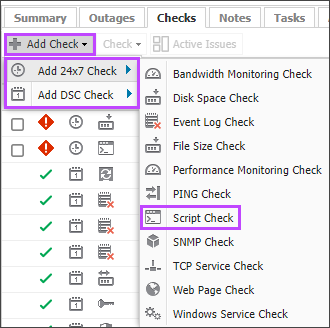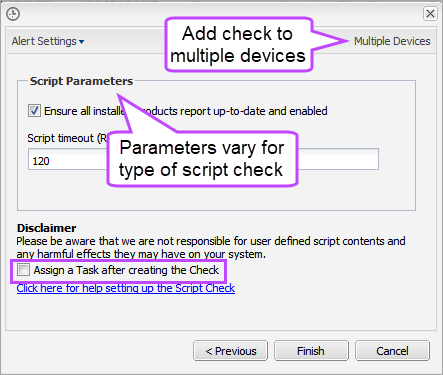Script Checks for Mac devices
To monitor your Mac devices, you can add system default script checks or your own user defined script checks to the devices. When you add a script check, configure the required parameter values.
Before adding a script check to a device, upload the script to the All Devices view. For upload instructions, see Add a script to Script Manager.
Default scripts with parameters for Mac devices
Expand the following sections for script descriptions and parameters:
- Queries
/Library/Managed Installs/InstallInfo.plistto check the installation status of patches deployed via Munki, including Managed Patch. - Does not report on patches deployed through other methods, such as manual user installation.
- Generates an alert if a patch installation fail, or if patches are queued and pending user logout.
- Report results are in the Script’s More Information section and the View the Managed Patch for Mac report.
- Script type: Python
| Parameter | Description |
|---|---|
| Script Timeout Range | Range: 1 - 3600 seconds (default 120 seconds) |
- Queries the computer to determine whether FileVault is enabled.
- Fails if FileVault is reported as off.
- Script type: Bash
| Parameter | Description |
|---|---|
| Script Timeout Range | Range: 1 - 3600 seconds (default 120 seconds) |
- Queries the computer to determine whether the firewall is enabled.
- Fails if the firewall is reported as off.
- Script type: Shell
| Parameter | Description |
|---|---|
| Script Timeout Range | Range: 1 - 3600 seconds (default 120 seconds) |
-
Queries the computer to determine whether the Gatekeeper is enabled.
Fails if Gatekeeper is reported as off.
- Script type: Shell
| Parameter | Description |
|---|---|
| Script Timeout Range | Range: 1 - 3600 seconds (default 120 seconds) |
-
Queries the system for changes to Transparency, Consent, and Control (TCC) permissions within the past 72 hours. This time frame accounts for weekend activity.
- Generates an alert if any permissions have changed during that period.
- Supports management using the Clear Check function.
- Queries the latest Time Machine snapshot to determine the backup status
- Generates an alert if the latest backup date is equal to or older than the specified number of days.
- Script type: Bash
| Parameter | Description |
|---|---|
| Days without backup | The number of days without a snapshot before the check fails |
| Script Timeout Range | Range: 1 - 3600 seconds (default 120 seconds) |
You can suppress check alerts until the number of consecutive check failures reaches the configured threshold. For details, see Configure alert thresholds to suppress alerts.Reviewed: 06 November 2025 (DK)
Check configuration
Add a script check to a device
- On the All Devices view, select the device in the North-pane.
- in the South-pane, go to the Checks tab.
-
Select Add Check , then choose the check frequency:
- Add 24x7 Check
- Add DSC Check

- Choose Script Check.
-
Select the script, then Next.
Scripts are grouped by default script categories (if applicable). The Linux Agent only supports User Defined scripts depending on the Operating system.
- Configure any script parameters, including the Command Line for custom scripts (if required).
To prevent the removal of a leading zero in command-line arguments, any part of the command that begins with 0 is wrapped in \ so the full argument is preserved during execution or processing.

To add the check to multiple devices at the same time, select Multiple Devices.
- To run an automated task when a check fails, select Assign a Task after creating the Check.
- Select Finish to save and apply the check.
If you selected Assign a Task:
- Choose the Automated Task script.
- Select Next to configure parameters.
- Enter any required Command Line or Script parameters.
- (Optional) Set maximum permitted execution time for the script.
- Select Finish to save and apply the task.
Reviewed: 10 November 2025 (DK)
Edit
Script Check - Endpoint Detection & Response (EDR) settings can't be edited. To remove them, you must uninstall EDR from the device.
- In the All Devices view North-pane, select the device.
- Go to the Checks tab in the South-pane.
- Right-click the check and choose Edit Check.
- Edit the script details and parameters.
- Select OK to save and apply.
Delete
- In the All Devices view North-pane, select a device.
- In the South-pane, go to the Checks tab .
- Right-click the check and choose Delete Check .
- Review the summary and select OK to confirm removal.
You can run custom scripts on servers and workstations using this product, but we don’t manage or validate them. We’re not liable for system, hardware, or data loss. Customers or developers must confirm the integrity and impact of any custom scripts.
What do you want to do?
